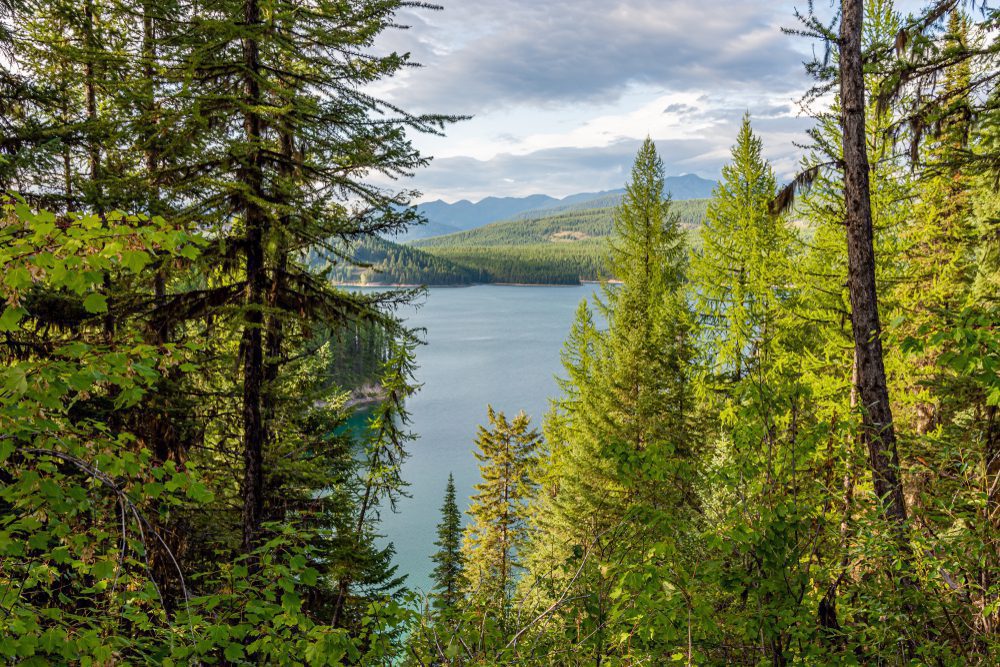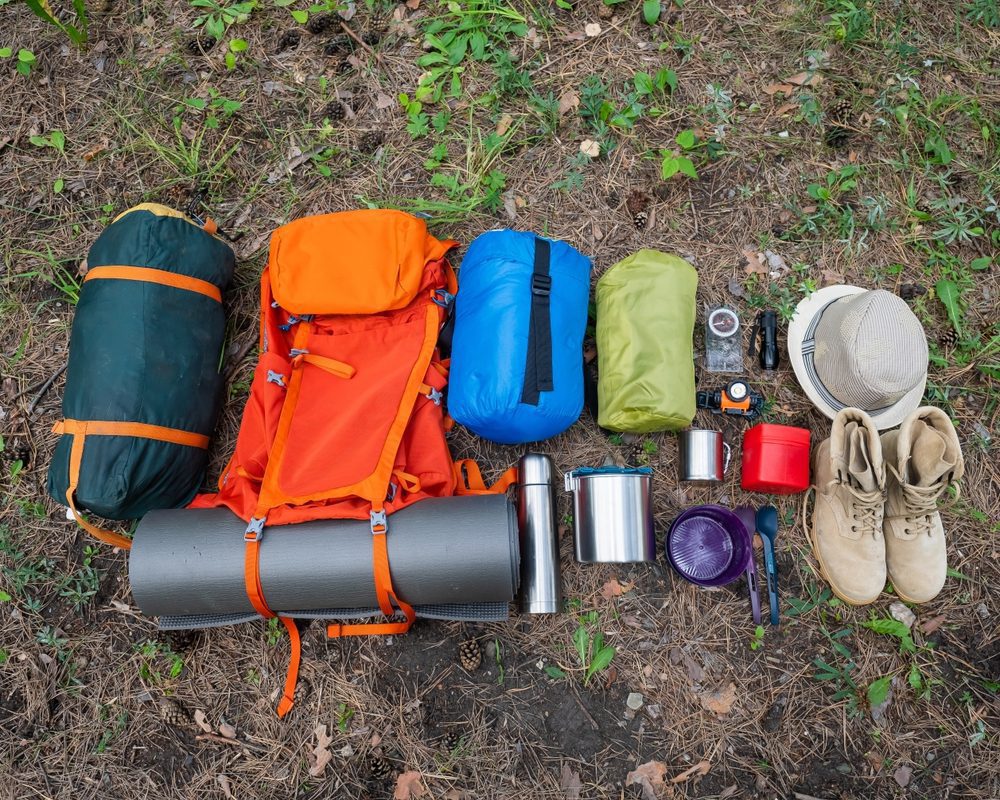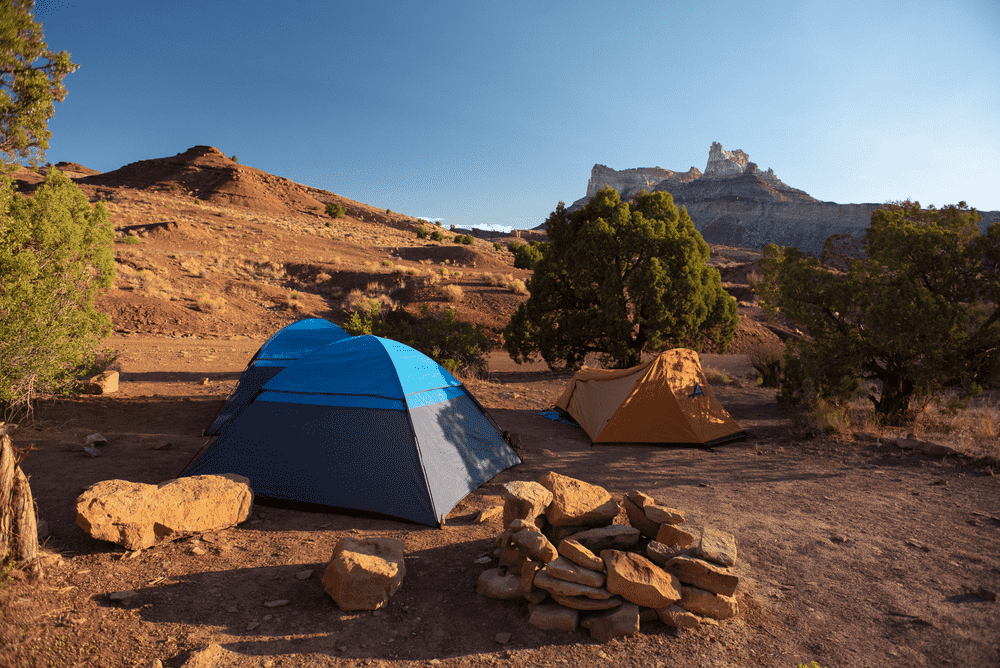This is the definitive guide how to find dispersed camping.
Dispersed camping, also known as primitive camping, boondocking, or backcountry camping, refers to camping outside of designated campgrounds and campsites. It typically takes place on public lands like national forests and Bureau of Land Management (BLM) land where camping is permitted. With dispersed camping, you can camp wherever you want as long as you follow certain guidelines and regulations.
The main defining feature of dispersed camping is the need for more facilities and amenities. There are no assigned campsites or RV hookups. Instead, you pick your spot to set up camp, whether it’s in a clearing in the woods, alongside a scenic river, or with views of mountain vistas. Dispersed camping offers a more rustic and adventurous camping experience away from crowds.
Table of Contents
Benefits of Dispersed Camping

The Authentic Camping Experience
One of the biggest perks of dispersed camping is the ability to enjoy a more authentic camping experience away from crowds and distractions. When you camp in the dispersed backcountry, it’s just you and nature. You can pick a scenic spot nestled in the woods, next to a babbling creek, or on a mountain ridge with sweeping views.
Without all the noises and lights of a busy campground, you can better immerse yourself in your natural surroundings. Dispersed camping lets you disconnect from technology and daily stresses and forge a deeper connection with the outdoors. It provides opportunities for reflection, solitude, and a minimalist camping experience.
Economic Advantages
Another major advantage of dispersed camping is the cost savings compared to campgrounds. The majority of dispersed camping is free on public lands managed by the Forest Service, BLM, and other state and federal agencies. Even if there is a small fee, it is nominal compared to the nightly rates at most private campgrounds.
In addition, you avoid the hassle of hard-to-get campground reservations that require booking months in advance. With dispersed camping, you can drive to your destination and pick a spot.
Environmental Benefits
Dispersed camping also offers some environmental advantages compared to developed campgrounds. By spreading out over a large area rather than concentrating all camping in specific campgrounds, the impact on the landscape is reduced. Rotating dispersed sites allows the surrounding vegetation time to recover.
In addition, dispersed camping encourages getting away from vehicles. Hiking or biking to your backcountry campsite reduces pollution and your overall impact on the environment. Following Leave No Trace principles helps ensure dispersed camping remains sustainable.
Is Dispersed Camping Free?

Cost Factors
Is Dispersed Camping Free? One of the biggest draws of how to find dispersed camping on public lands is the opportunity for free or very low-cost overnight stays. National forests and BLM lands typically allow free camping wherever it is permitted. There are some exceptions, though:
- Some national forests require a permit for overnight stays, which may have a small fee.
- In a few areas, like national conservation areas, camping fees may apply.
- If you camp in an area like a State Park that normally charges for camping, dispersed camping may still require paying the standard camping fee.
So, while dispersed camping is largely free, it’s always wise to check with the local land management agency to see if any permits or fees apply for camping outside of designated campgrounds.
Hidden Costs
While dispersed camping eliminates the nightly camping fee, there are some hidden costs to factor in:
- Gas for driving to remote camping areas
- Vehicle maintenance for rough dirt roads
- Gear like a roof-top tent or camping trailer to access backcountry sites
- Camping equipment for comfort and safety in the wilderness
- Possible camping permits/passes depending on the location
Make sure to budget for gas, wear and tear on your vehicle, and any gear you may need to camp off the grid. The cost of dispersed camping adds up compared to pulling into an easily accessible campground. But the trade-off is a unique camping experience away from crowds and distractions.
Challenges of How To Find Dispersed Camping
Lack of Facilities
The biggest challenge with dispersed camping is the need for more facilities and amenities. There are no bathrooms, showers, picnic tables, fire rings, or any developed infrastructure. It would help if you were fully self-sufficient:
- No restrooms mean you’ll need a portable toilet or need to dig catholes.
- No picnic tables or fire rings means bringing your chairs, and tables, and establishing your fire pit.
- No water hookups mean you must pack in all the water you’ll need for drinking, cooking, etc.
You also won’t have conveniences like electrical hookups, WiFi, or cell phone reception. Dispersed camping requires being prepared to camp without any facilities or modern conveniences.
Finding the Perfect Spot
Finding the ideal dispersed camping spot can also be a challenge. Unlike a campground with assigned sites, you need to scout locations, assess potential sites, and pick one that meets your needs. Considerations include:
- Access – Can your vehicle reach the spot, or is hiking required?
- Terrain – Is the ground flat, rocky, or sloped?
- Privacy – Is the site secluded, or can others see your tent?
- Views – Are there scenic vistas of lakes, mountains, etc?
- Water access – Is there a creek or lake nearby?
It takes time, effort, and knowledge of the area to find dispersed camping sites with the right features and atmosphere you desire. For novice dispersed campers, locating an ideal site can be frustrating.
How to Find Dispersed Camping Sites

Utilizing the BLM Website and Interactive Maps
How to find dispersed camping sites ? One of the best resources for finding dispersed camping sites is the Bureau of Land Management’s (BLM)
website. The BLM manages over 245 million acres of public lands, much of which is open to dispersed camping. The website includes an interactive map that allows you to search for camping locations by selecting a state.
You can filter campsites based on amenities like hiking, fishing, hunting, and more. Clicking on a campsite icon provides details on location, facilities, road access, fees, and contact information. This makes it easy to find dispersed camping sites on BLM lands near activities you enjoy.
Asking a Ranger
Speaking with a park ranger or visitor center staff is another excellent way to discover dispersed camping options. Explain the type of experience you’re looking for, and they can recommend lesser-known areas ideal for dispersed camping. Rangers have intimate knowledge of recreation opportunities across the public lands they manage.
Visitor centers often have free maps highlighting the most popular dispersed camping zones. Rangers can also inform you of any permits, fees, or regulations that may apply to backcountry camping in a particular area. Their insights help ensure you find great campsites and have a safe, enjoyable experience.
Using Google Maps
Google Maps and Google Earth are handy tools for scouting potential dispersed camping locations, especially for evaluating road access. Switching to satellite views allows you to zoom in on public lands and look for clearings, lakes, ridges, or other promising areas conducive to dispersed camping.
Scanning for logging roads, 4WD trails, and other dirt access roads can reveal locations you may need help finding on a map. Always cross-reference against motor vehicle use maps from the Forest Service or BLM to confirm vehicles are allowed on any backcountry roads.
Online Resources and Apps for Finding Dispersed Campsites
There are several websites and mobile apps dedicated to helping you discover dispersed camping locations:
- FreeCampsites.net – Database of over 14,000 free and cheap campsites on public lands.
- Campendium – Crowdsourced reviews and maps of dispersed campsites across the US and Canada.
- iOverlander – User-submitted information on backcountry camping spots ideal for overlanding.
- The Dyrt – Camping app with user reviews and tips on finding dispersed camping areas.
These resources allow you to quickly search for dispersed camping by location, see photos, read reviews from other campers, and navigate to promising sites. They make it easier to research locations before your trip.
Word of Mouth and Local Insights
Speaking with locals like park employees, outdoor gear shop staff, and other overlanders is a great way to uncover hidden dispersed camping gems. People familiar with the area can share spots they enjoy that are less well-known.
Online forums and Facebook groups focused on dispersed camping are also helpful for sourcing insider tips. Connecting with the dispersed camping community allows you to leverage knowledge from more experienced campers. Just be sure to follow LNT principles when visiting new undeveloped sites.
Preparing for Dispersed Camping

Essential Gear Checklist
The key to enjoyable and safe dispersed camping is packing the right gear. With no facilities or amenities, you must bring everything you’ll need. Recommended gear includes:
- Navigation – maps, compass, GPS device
- Shelter – tent, tarp, hammock, sleeping bag, sleeping pad
- Food – cooler, camp stove, mess kit, utensils
- Water – filtration or purification method, hydration packs, collapsible jugs
- Clothing – layers, hiking boots, rain jacket, warm hat
- Safety – first aid kit, fire ext
- extinguisher, headlamp, whistle
- Sanitation – portable toilet or trowel for catholes, toilet paper, hand sanitizer, biodegradable soap
- Power – portable battery packs, solar charger
- Fire – matches, lighter, newspaper, kindling, campfire wood
- Tools – knife, multi-tool, rope, duct tape, zip ties
- Comfort – camp chairs, sun shade, bug repellent, entertainment
Double-check all systems before your trip and ensure you have the necessary supplies for an enjoyable and safe off-grid camping experience.
Best Practices for a Safe Experience
Beyond having proper gear, following certain dispersed camping best practices helps ensure a fun and safe adventure:
- Research regulations and get permits if required
- Pack plenty of water and food
- Tell someone your plans and expected return time
- Scout the area in daylight before setting up camp
- Look for existing fire rings if building a campfire
- Choose a site at least 200 feet from water sources
- Watch the weather forecast and evacuate for severe storms
- Store food and trash securely to minimize wildlife encounters
- Bring multiple forms of navigation – map, compass, GPS device
- Carry a first aid kit and know basic wilderness medical skills
Applying backcountry common sense helps keep you safe and reduce your impact on the environment. Dispersed camping responsibly allows us to protect these wild places.
The Principles of Leave No Trace

Adhering to Leave No Trace (LNT) principles is crucial when dispersed camping to minimize your environmental impact and help preserve the backcountry. The seven LNT principles are:
Plan and Prepare
Know the regulations, permits required and weather forecast. Pack proper gear and maps. Calculate how much food, water, and fuel you’ll require. Repackage food to minimize waste. Prepare for waste disposal and emergencies.
Travel & Camp on Durable Surfaces
Hike single file on established trails. Choose hardened campsites. Avoid damaging vegetation and digging trenches. Spread out tents and concentrate activity where impact already exists.
Dispose of Waste Properly
Pack out all trash. Bury human waste is at least 6-8 inches deep and 200 feet from water sources. Use biodegradable soap. Scatter dishwater. Avoid contaminating natural water sources.
Leave What You Find
Allow others the same sense of discovery. Leave plants, rocks, artifacts, and other objects of interest undisturbed. Avoid damaging live trees and plants. Respect private property.
Minimize Campfire Impacts
Use established fire rings or mound fires on bare soil. Keep fires small. Burn all wood to ash and drown fires thoroughly. Be certain fires are legal and safe, given conditions.
Respect Wildlife
Observe wildlife from afar. Never approach, feed, or follow animals. Protect food from bears and other critters. Store toiletries securely. Leave pets at home. If you love birdwatching you can learn about woodpecker.
Be Considerate of Other Visitors
Let nature’s sounds prevail. Keep voices low. Maintain clean campsites. Park considerately. Share the trail. Respect private property and other user groups.
Following LNT principles protects the backcountry and ensures public lands remain unspoiled by human activity. Education on and adherence to these guidelines allows dispersed camping to remain sustainable.
Conclusion: The Joy of Dispersed Camping

Embracing the Adventure
Dispersed camping lets us embrace adventure and forge a deeper connection with nature. The freedom to wander remote public lands and make your path lies at the heart of this camping style. There’s something profoundly rewarding about self-sufficiency in the wilderness.
From stunning mountain vistas to lush forest clearings, dispersed camping provides access to remarkable landscapes. Without the noise, lights, and crowds of a campground, you become more attuned to the subtle wonders of the natural world. The stars shine brighter. The rush of a river soothes deeper. The rise of the sun fuels inspiration.
The rugged beauty and solitude of dispersed camping rejuvenates our weary souls. It provides a canvas for renewal, reflection, and recreation away from the distractions and stress of daily life. We emerge revitalized and eager to protect what remains wild.
The Call to Responsibility
With the benefits of dispersed camping also comes responsibility. We must educate ourselves on regulations, travel, and camp conscientiously, and follow Leave No Trace ethics. It’s our shared duty to preserve these public lands for future generations.
We should leave campsites in better condition than we found them and help instill in others respect for the backcountry. Volunteering, picking up trash, and restoring overused areas protect our playground. With knowledge and care, dispersed camping remains sustainable.
Dispersed camping allows us to rediscover a sense of wonder, freedom, and connection with the natural world that often fades in the country. As we embrace the adventure, may we also accept the call to responsibility. Our children and grandchildren deserve to experience the same wildness.





